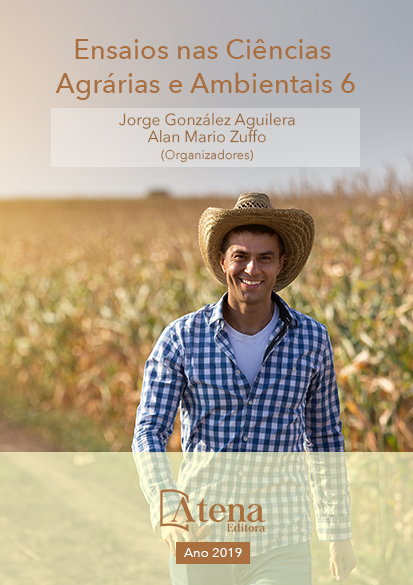
TEOR DE MATÉRIA ORGÂNICA DE UM NEOSSOLO QUARTZARÊNICO SUBMETIDO À APLICAÇÃO DE ÁGUA RESIDUÁRIA DA MANDIOCA
Os resíduos agroindustriais é uma
alternativa economicamente viável para a
reposição dos nutrientes extraídos e exportados
do solo. Esses resíduos possuem nutrientes
em sua composição que são requeridos pelas
plantas durante todo seu ciclo produtivo.
Entretanto, o manejo inadequado desses
resíduos ainda é uma prática frequente e tem
causado grandes prejuízos para o ambiente.
Assim, o objetivo deste trabalho foi avaliar
o teor de matéria orgânica em um Neossolo
Quartzarênico submetido ao uso da água
residuária da mandioca. O delineamento
experimental utilizado foi em blocos ao acaso
com cinco tratamentos (0; 15; 30; 60 e 120
m³ ha-1 de manipueira), e quatro repetições. A
forrageira utilizada foi a Brachiaria brizantha
cv. Marandu. A manipueira foi dividida em duas
aplicações, sendo os primeiros 50% aplicados
após o corte de uniformização e o restante logo
após o primeiro corte. Foram realizados três
cortes. O solo foi coletado após o terceiro corte,
nas profundidades de 0 a 10 e 10 a 20 cm, e
em seguida encaminhados ao laboratório, onde
foi determinado o teor matéria orgânica. Com
o aumento das doses de manipueira, o teor de
matéria orgânica nas profundidades de 0 a 10 cm
apresentou uma resposta linear decrescente. O
decréscimo da matéria orgânica do solo ocorreu
provavelmente devido à grande quantidade
de nitrogênio presente na neste resíduo. Com
isso, à medida que se aumentou a dose de
manipueira no solo, a taxa de decomposição da
matéria orgânica aumentou.
TEOR DE MATÉRIA ORGÂNICA DE UM NEOSSOLO QUARTZARÊNICO SUBMETIDO À APLICAÇÃO DE ÁGUA RESIDUÁRIA DA MANDIOCA
-
DOI: 10.22533/at.ed.42119160120
-
Palavras-chave: Biofertilizante, manipueira, impactos ambientais.
-
Keywords: Biofertilizer, cassava wastewater, environmental impacts.
-
Abstract:
The agroindustrial residues are
an economically viable alternative for the
replacement of nutrients extracted and exported
from the soil. These residues have nutrients
in their composition that are required by plants throughout their productive cycle.
However, the inadequate management of this waste is still a frequent practice and
has caused great damage to the environment. Thus, the objective of this work was
to evaluate the organic matter content in a Quartzarenic Neosol submitted to the use
of cassava wastewater. The experimental design was in randomized blocks with five
treatments (0, 15, 30, 60 and 120 m³ ha-1 of cassava wastewater), and four replications.
The forage used was Brachiaria brizantha cv. Marandu. The cassava wastewater was
divided into two applications, the first 50% being applied after the standardization cut
and the remainder immediately after the first cut. Three cuts were made. The soil was
collected after the third cut, at depths of 0 to 10 and 10 to 20 cm, and then sent to the
laboratory, where the organic matter content was determined. With the increase of the
doses of cassava wastewater, the organic matter content in the depths of 0 to 10 cm
presented a decreasing linear response. The decrease in soil organic matter probably
occurred due to the large amount of nitrogen present in this residue. Thus, as the
dose of mango tree in the soil was increased, the rate of organic matter decomposition
increased.
-
Número de páginas: 15
- Éric George Morais


